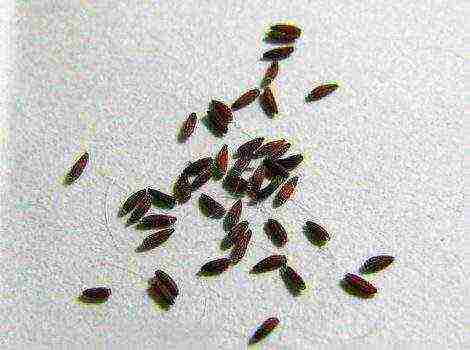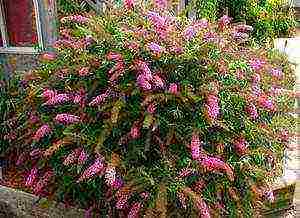Content
How to store seedlings in the spring before planting at home
In February-April, the active sale of seedlings begins. At fairs and nurseries, boxes with future trees, shrubs, flowers are full of. Eyes run up, and there is a desire to buy a lot of things at once. You should not refuse, there are several ways how to preserve seedlings before planting at home.
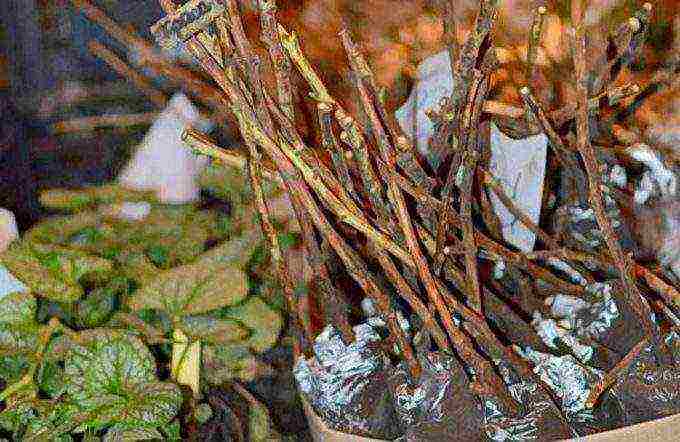
Inspection and preparation
Before storing purchased seedlings, you need to immediately mark (hang a tag with the name of the variety), inspect the buds and roots.
The introduced specimens in February-March, most likely, still have dormant buds.

There may also be those that have already grown, but still small, no more than 2 cm. They are also suitable for "sealing".
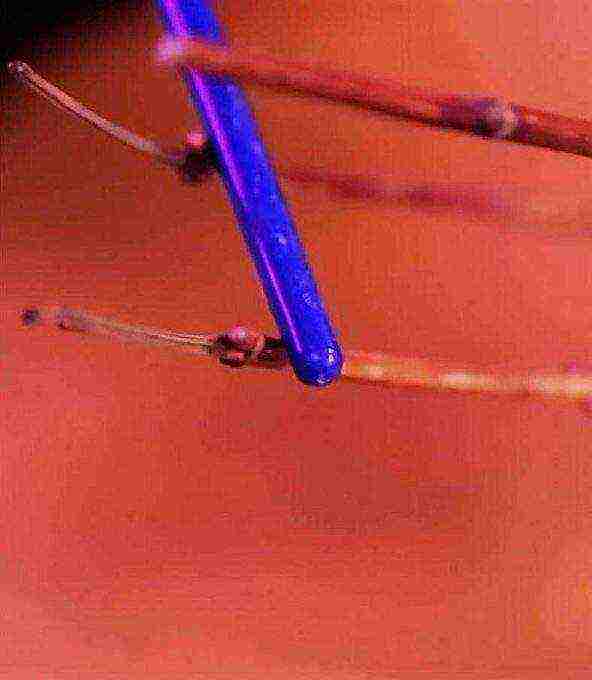
If the buds are already actively growing, then before planting in a permanent place, the seedling is planted in a pot as a houseplant.
Cut off soaked and broken off roots, long, dry or diseased shoots with a garden pruner. Shorten long roots. Treat the cuts with brilliant green or sprinkle with crushed coal.
Shoots damaged by the fungus cannot be left for storage, the disease will spread throughout the seedling and by the time of planting there will be nothing to plant.
If young trees were sent by mail, then the root system could dry out. Before storing, wrap the spines in a damp cotton cloth and hold for a while.
In grafted specimens, especially rose seedlings, the site of grafting is checked. Often there is no protective paraffin plug and to protect the sensitive area, it is wrapped in polyethylene.
How to preserve seedlings before planting
It is difficult to keep the purchased seedlings at home, because in addition to the coolness, you still need to find a place. We offer several options:
- Prepare a clean, thin plastic wrap, punch holes in it for ventilation. Wrap the seedlings, then wrap them in newspaper to protect them from light, and secure with elastic bands or ribbons. Place in dry plastic containers and store in a cool, dark place.
- The cuttings are usually small and can be stored in the refrigerator on the bottom shelf.
- Large seedlings of trees and shrubs are placed in boxes with wet sand, while the roots are not wrapped.
- To prevent the root system from drying out, place it in a plastic bag, make several holes in it so that the roots do not start to rot. Wrap the top with newspaper and secure with ribbons or an elastic band. Place in a plastic container and place in a dark, cool place; at home, a balcony would be the best option.
A hood made of newspaper or covering material, put on the seedling, will protect from sunlight, thereby prolonging the dormant period.
- Plant as a houseplant. Note that each pot has drainage holes that we don't need. So that the water does not wash out, the bottom of the pot is covered with a cloth and only then the earth is poured.
Soak cuttings or seedlings in potassium humate before planting. How to prepare the solution is indicated on the package. After planting, move the pot to a room where the temperature ranges from 5-7 ° C. When the buds wake up and begin to grow, transfer the pot to a bright, cool place.
You can save grape shoots before planting in other ways, more details can be found in the topic "How to save grape cuttings in winter."
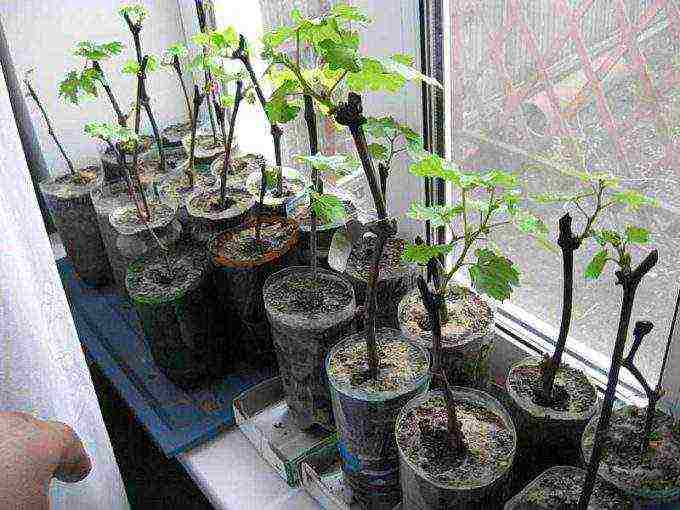
Storage conditions
It is important to monitor temperature and humidity levels prior to planting. A hygrometer will be a good helper here. The ambient temperature should be within 0 ... + 2 ° С. It is with her that the plants fall into a state of dormancy and calmly survive the waiting time.
If the apartment is on the ground floor and there is a cellar, then it is better to transfer the seedlings for storage until they are planted in the cellar.
During rest, do not open the planting material, and do not touch it again, it is quite enough once a month to very carefully check the condition of the kidneys.
If the seedlings are bought in the fall, but you need to save it until spring, then for the winter they are placed in a pit. To protect against field rodents, spread juniper or spruce branches on top.
Sponsored Links

Buying plants is a responsible business. Let's talk about that. what you need to pay attention to when choosing seedlings of fruit and ornamental trees and shrubs
SPRING - TIME TO BUY PLANTS, BOTH FRUITS AND DECORATIVE. IT IS IMPORTANT NOT ONLY TO CHOOSE THE RIGHT TREE, SHRUB OR FLOWER, BUT ALSO PRESERVE IT BEFORE PLANTING IN THE GARDEN. ABOUT THIS AND LET'S TALK
We will learn to choose, store and plant planting material in the spring.
Seedlings grown in containers are the easiest to transplant, their root system is well developed, not disturbed, such plants quickly take root and grow. It turns out that we simply transfer the plants: when we take them out of the container and plant in the garden, we preserve the integrity of the root system.
Seedlings grown in the field, in the nursery, are often wrapped in foil, after adding nutritious soil to the roots and forming a briquette, which is placed in a colorful package. The root system of such plants does not dry out; in this state, the seedling can be stored for several months.
See also: Storage of seedlings - how to save before spring planting?
Fruit trees
WE BUY SEEDLINGS
Before purchasing a seedling, inspect it carefully.
He must be healthy, the bark must not be damaged. This is the first thing to pay attention to.
When buying in a frosty period, pay attention to the buds: they should be dormant, and the seedling itself should not be overdried (which is well displayed on the bark, it becomes wrinkled, a slight crunch is heard when bent).
The shoots of a healthy seedling are elastic, bend easily, have an even bark color, and the buds are clearly visible.
Examine the vaccination site carefully:one hundred accretion of rootstock and scion must be clean, with a characteristic scar.
The tops of the seedlings can be pruned - it's not scary; form a new leader during the growing season, and after a year or two you will not see the cut.
Opened buds on a seedling are permissible, in this case, we can plant it immediately in a permanent place, and there is no need for storage.
WE SAVE BEFORE LANDING
Do not bring purchased seedlings into the heat., by doing this you will only stimulate growth. Wrap them in a nonwoven covering material and store them in a cold room until planting (ideally in a cellar, cold basement, garage, or even on a balcony).
Check the condition of the soil, do not let it dry out, moisturize in a timely manner, but also do not fill.
The seedling must be accompanied by a label indicating the variety, it must be attached to the seedling or to the container in which it was grown.
Protect the plant from sunburn before planting (or immediately after);
You can use covering material or garden whitewash.
Fruit shrubs
All seedlings of fruit bushes (currants, gooseberries, raspberries, honeysuckle, blackberries) grown in containers, after purchase, can be stored outdoors in the shade or in a cold room until disembarked in a permanent place.
Seedlings with an open root systempurchased from the nursery, immediately place in a bag, wrap the roots in cloth or paper, moisturize and keep in the shade. In the garden, if the planting site is not yet ready, dig in the seedlings in the garden bed, sprinkle the roots with soil, and water well. It is not necessary to soak such seedlings; some immerse them in a bucket of water - that's a mistake! An attempt to soak dried seedlings, of course, has the right to be, but in this case it is much more effective to cut the roots with a sharp pruner, shorten the shoots greatly, and then plant the plant in loose fertile soil and water it well.
Blackberry and raspberry seedlings should be chosen with care... Do not forget that the shoots of these crops live for two years. In the first year they gain vegetative mass, in the second year they bloom and give berries, after which they dry up. Therefore, the seedlings should be shoots of the first year, and they will give the first harvest only in the second year.
Perennials
Perennial flower crops are most often offered by sellers in the spring. The desire to purchase a new variety is great, and colorful packaging appears already in February. But it is still very early, and we do not understand what to do with them, how to save them until they are planted in the garden in April-May.
MODERN VARIETIES OF HYBRID Iris amaze the imagination with the shape and color of the flowers (white, pink, crimson, blue, blue). Old varieties are often found on garden plots, many consider them almost weedy, often planted from the site on the side of garden roads; even thrown away, they often take root, grow and bloom beautifully in wastelands.
Modern varieties, in contrast to the "unkillable" old ones, are often capricious, which undoubtedly pays off for their beauty.
In the spring, dealerships of the coveted rhizome with one "spatula" of leaves appear on sale (this is how the fan of iris leaves is called). Carefully inspect the cut: there should be no rot, sores and damage. Remember that it is better to dry this plant (even if the leaves are almost dry, they will tolerate it more easily) than to keep it very moist. It rots easily when wet.
Damaged rhizomes of iris can be cured, rotten parts can be cut with a sharp knife to healthy tissue, and the cut can be powdered with crushed charcoal or treated with ordinary brilliant green, applying it to the cut with a cotton swab. Store the rhizomes in a cool, dry place, rarely dampening slightly to avoid drying out.
Daylilies and hosts have a well-developed root system, often with only one bud. Such delenki are most often found in bags with ventilation holes. Choose healthy specimens with a well-formed kidney. They should be planted in peat pots and placed in a cold room or cellar, periodically slightly moistening. And in the garden, they can be planted in a permanent place along with the pot.
Hosta... Please carefully read the description of the variety before purchasing. Pay attention to the size of the bush: hosts are very different in size of leaves - there are giants with a bush up to a meter in size, and there are babies whose bush is no more than 20 cm. Consider this when planting in a permanent place.
Day-lily... This plant, on the contrary, grows well in the sun - it practically does not bloom in deep shade and grows poorly. The varietal variety of this perennial captivates with its many colors, long flowering and unpretentiousness.
ON A NOTE
I want to draw your attention to the lilac. There is an opinion that it is easy to propagate it - just dig up the growth and plant it.
But disappointment comes when the planted shoots bloom: instead of the desired variety, the most common lilac blooms. The point is this: varieties are often propagated by grafting, grafting varietals on wild shoots - which blooms with you if you separate the shoots from it. Varietal lilacs have a weak root system, so it is advisable to propagate them by grafting, like apple trees, pears, plums.
Reference by topic: Choosing quality seedlings - types of rootstock, planting and care
How to preserve seedlings before planting in open ground
Saplings: how to choose and save correctly. (11.02.16 g.)
Sponsored Links
Below are other entries on the topic "How to do it yourself - a householder!"
How to store seedlings in a trench? Do-it-yourself attachment for seedlings Acquired ... When is it better to plant seedlings - in autumn or spring? Which tree planting is better - ... How to store rose seedlings Correctly store seedlings of the queen of flowersSo ... Smolensk method of planting seedlings and a garden according to this system How to plant trees according to "Smolensk ... Storage of seedlings - how to save until spring planting? HOW TO SAVE SEEDLINGS TILL SPRING ... Do-it-yourself autumn planting of an orchard - professionals advise Autumn planting of seedlings - from ... How to preserve planting material until spring How to store seedlings and cuttings ...
Subscribe to updates in our groups.
Let's be friends!
Very often such a problem is encountered among summer residents - they purchased or ordered by mail the necessary seedlings of ornamental or fruit crops, and it is too early to plant or there is no time to plant. What they usually do is cover the roots, store in a cool place until planting. Saplings start to grow, white thin roots develop - the most important plant feeders when planting. Then they bring them to the site, these roots die, because. practically do not tolerate the slightest drying out. As a result, the seedling is sick for a long time and does not soon begin to please the eye. In our farm we practice early planting in containers - fortunately, there are a lot of them on sale now - of any size. The substrate is peat with fertile soil 1: 1. As a result, we get seedlings with a closed root system in containers that are not afraid of replanting even in summer. You can see for yourself in the photo - a rose at the end of May.
Hello dear gardeners, gardeners and flower growers! Spring, you all acquire some plants, some of you have mapped out a road to one garden center, someone mapped a road to some nursery, but be sure, I beg you, I just beg you, get perennial plants here only in good companies, only in good stores, only in good nurseries! In no case do not allow yourself to buy plants somewhere on the roads from some random sellers. You can lose not only money, time, energy, but also nerves.
How to preserve seedlings of trees and shrubs before planting in open ground
So, you have purchased a one-year-old seedling, for example, an apple tree. It should look something like this. An annual seedling is literally a twig. If several lateral shoots have suddenly formed on the seedling, then this is already a two-year-old seedling. Of course, in such packaging it is not entirely clear what is there, what roots, but, nevertheless, firms do not compromise themselves, therefore, as a rule, they make good packaging, as you see in this case. There is a substrate, the roots are clearly moistened, the substrate is moist - now we will see that - well wrapped. See what kind of substrate? Wet. So I touch my finger - my finger gets dirty. We must open it, and before planting it is already in the garden - and it is too early to plant, we still cannot prepare the pits, because the soil is frozen - during this time we must help the plant at least a little. We will take it and put it in some kind of container, in a pot. Do not keep it somewhere in the bath or in the kitchen on the floor, but take this plant of your own to the balcony. On the balcony, it will continue to rest remarkably. You see, the kidneys are still dormant. And at this time, you should try to choose a plant with dormant buds, so that the buds are tight, the tissues are elastic at the shoots. This is how they should bend. This means that the plant is lively, pretty, the kidneys are plump.
We check the condition of the trunk of the purchased tree or shrub sapling
Here is our root system. It often happens that the grower twists the roots when they are too large. And we see with you that the tip of the spine is white. This means that the plant has already come to life, which means that it is about to start growing.And once in such a container as it was, it is clear that this apple tree can simply die, despite the fact that you buy a good product.
So we freed the roots a little from the substrate, gave them freedom. For such a root system, such a two-liter capacity will be enough. You can fill the drainage, or you can not fill it, because if you fill the drainage, the root system will be cramped. Therefore, it's okay, for a month or a month and a half, this plant will simply stay with us in a new container with neat watering, maybe we even have to feed the plant a little. We sprinkle the soil. But what kind of soil? You can take, for example, such a soil - garden, or a universal soil prepared by us in advance, where we have land from the garden, and river sand, and very good peat, and perlite, vermiculite. So the soil - just sit down and grow on its own.
We check the condition of the roots of the purchased tree or shrub sapling
So, we take with you, we pour a little soil on the bottom - we should always do this - so that the bottom is not naked, and the roots do not immediately lie on the bottom. Sprinkle our plant with this earth of ours. Good commercial land can be used, but not peat. Dear friends, please do not buy these peat pillows that are selling. The soil will surely dry out, then get wet, there will not be enough food, or, on the contrary, the food will be so unevenly supplied to the roots - it is thick, then empty - and this will not make them feel good, these roots will die. So you can even alternate your land with purchased land - a handful of one soil, a handful of another. The soil should have a reaction somewhere around 5.5-6. This is a very good reaction. This is how we compact the soil, especially around the perimeter. We shed a clod of earth, actively water the soil so that it snuggles to the roots. The roots will immediately feel the moisture and begin their work. Let's add a little more. But there is no need to rush the plant, no need to wake it up ahead of time. If there is some kind of cold, rather light room, then it will normally stay in it. There is no need to rush. Why? Because sometimes plants wake up early. It would seem that in May you can already plant it, it is already with leaves, but these leaves are not needed, because there may be frosts, and frosts will definitely destroy these leaves, and you will have to cover these plants. Therefore, do not wake up your plants ahead of time.
We transplant the seedling into a seedling container
Thus we watered, temporarily planted. Again, the root system, growing in this pot, covering this new soil, feeding on good elements that we can include after 1-2 waterings, say, mineral fertilizers ... Every third watering we apply mineral fertilizers. Be sure to use annotation. You don't need much. Less is better than more. And be sure to try to treat the plant from diseases and pests during this period before planting. There are a lot of drugs now. From diseases, as a rule, these are copper-containing drugs, from pests you will find these drugs everywhere in the markets and in stores, ask, exactly, good universal drugs, so that no infection can be brought into your garden.
Dear friends, I wish you all the best, great success and the acquisition of wonderful seedlings.
Nikolay Petrovich Fursov, Candidate of Agricultural Sciences.

